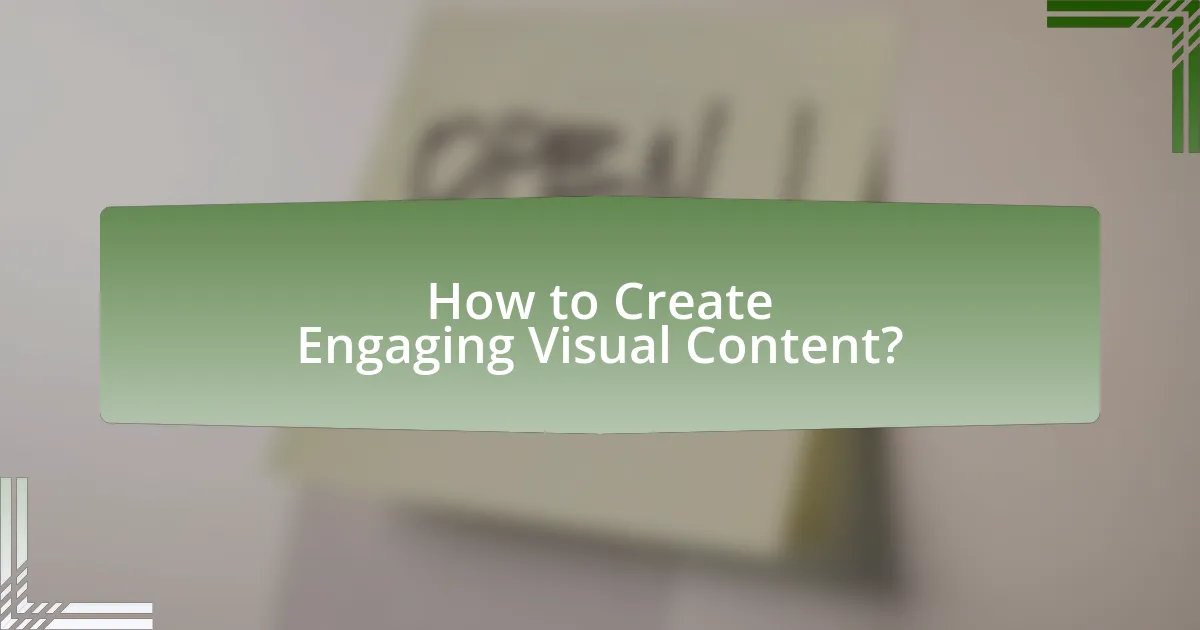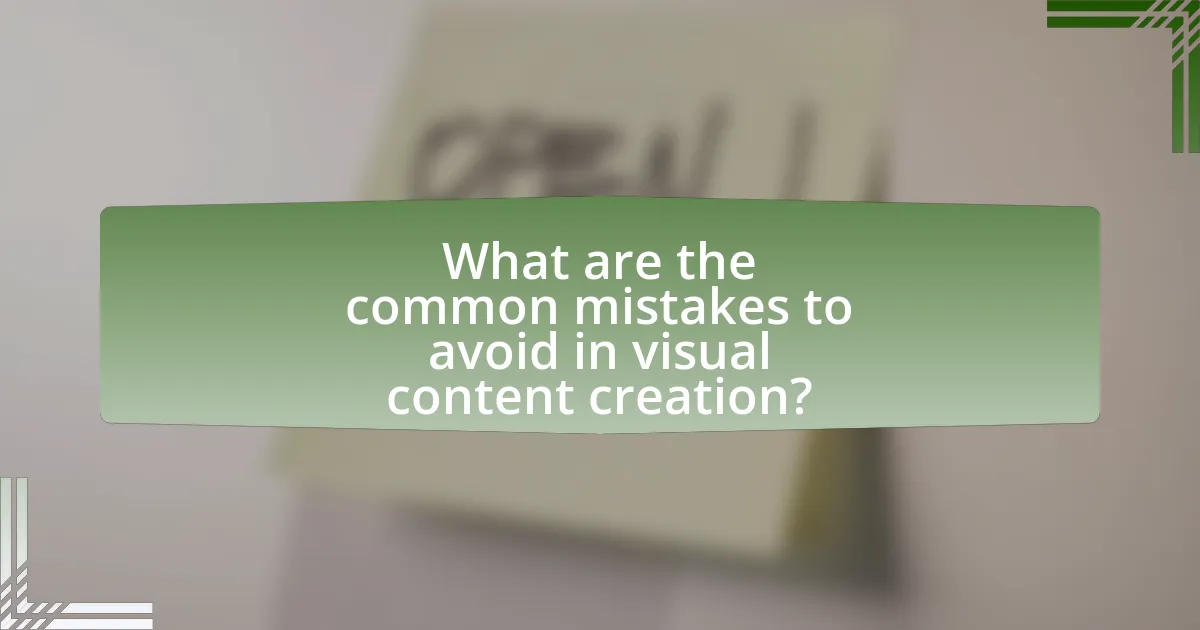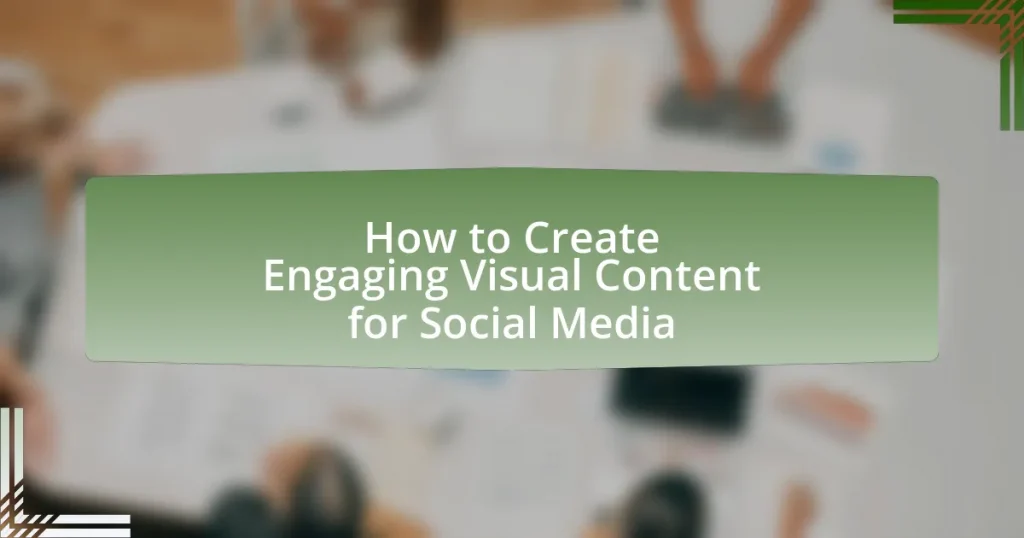Engaging visual content for social media encompasses images, videos, infographics, and animations that effectively capture audience attention and drive interaction. This article explores the impact of visual content on social media engagement, highlighting its ability to enhance user interaction rates and brand recognition. It discusses various types of effective visual content, best practices for design, and tools available for creating compelling visuals. Additionally, the article addresses common mistakes to avoid and strategies to leverage user-generated content, ensuring that brands can optimize their social media presence through impactful visual storytelling.

What is Engaging Visual Content for Social Media?
Engaging visual content for social media refers to images, videos, infographics, and animations that capture the audience’s attention and encourage interaction. This type of content is designed to be visually appealing and relevant to the target audience, often incorporating elements like vibrant colors, compelling narratives, and clear messaging. Research indicates that posts with visuals receive 94% more views than those without, highlighting the effectiveness of engaging visuals in driving user engagement and sharing.
How does visual content impact social media engagement?
Visual content significantly enhances social media engagement by capturing attention and increasing interaction rates. Studies indicate that posts with images receive 94% more views than those without, demonstrating the effectiveness of visuals in attracting users. Additionally, visual content is processed 60,000 times faster than text, leading to quicker comprehension and retention of information. This rapid processing encourages users to engage more, as they are more likely to share, comment, or like visually appealing posts. Furthermore, platforms like Instagram and Pinterest, which prioritize visual content, show higher engagement metrics compared to text-heavy platforms, reinforcing the importance of visuals in social media strategies.
What types of visual content are most effective for engagement?
The types of visual content most effective for engagement include videos, infographics, and images. Videos capture attention quickly and can convey complex messages in a short time; studies show that social media posts with videos receive 48% more views. Infographics present data in a visually appealing way, making it easier for audiences to digest information; research indicates that infographics are shared three times more than other types of content. Images, particularly high-quality and relatable ones, evoke emotional responses and increase sharing rates; posts with images are known to generate 650% more engagement than text-only posts.
How do visuals influence user behavior on social media platforms?
Visuals significantly influence user behavior on social media platforms by enhancing engagement and retention. Research indicates that posts with images receive 94% more views than those without, demonstrating that visuals capture attention more effectively. Additionally, studies show that content with relevant images is 650% more likely to be shared, indicating that visuals not only attract users but also encourage them to interact and disseminate the content further. This behavior is driven by the brain’s preference for visual information, as it processes images 60,000 times faster than text, leading to quicker comprehension and emotional connection.
Why is visual content important for social media marketing?
Visual content is important for social media marketing because it significantly enhances user engagement and retention. Studies show that posts with visuals receive 94% more views than those without, highlighting the effectiveness of images and videos in capturing attention. Additionally, visual content is processed 60,000 times faster by the brain compared to text, making it a crucial element for conveying messages quickly and effectively. This rapid processing leads to higher sharing rates, as content that resonates visually is more likely to be shared, thereby increasing brand visibility and reach.
What role does visual content play in brand recognition?
Visual content significantly enhances brand recognition by creating memorable associations and increasing engagement. Studies show that visuals are processed 60,000 times faster than text, making them crucial for capturing attention quickly. Furthermore, consistent use of colors, logos, and imagery across platforms reinforces brand identity, leading to a 23% increase in brand recall, as reported by the University of Loyola, Maryland. This demonstrates that effective visual content not only attracts attention but also solidifies a brand’s presence in consumers’ minds.
How does visual content enhance storytelling in social media?
Visual content enhances storytelling in social media by capturing attention and conveying messages more effectively than text alone. Studies show that posts with images receive 94% more views than those without, highlighting the importance of visuals in engaging audiences. Additionally, visual elements such as infographics and videos can simplify complex information, making it easier for users to understand and retain the narrative being presented. This combination of attention-grabbing visuals and clear communication significantly boosts user engagement and sharing, ultimately leading to a more impactful storytelling experience on social media platforms.

How to Create Engaging Visual Content?
To create engaging visual content, focus on high-quality images, compelling graphics, and relevant videos that resonate with your target audience. Research indicates that posts with visuals receive 94% more views than those without, highlighting the importance of visual appeal in capturing attention. Utilize tools like Canva or Adobe Spark to design eye-catching visuals that align with your brand identity and message. Additionally, incorporating user-generated content can enhance engagement, as it fosters community and authenticity, making your visuals more relatable and trustworthy.
What tools can be used to create visual content for social media?
Tools that can be used to create visual content for social media include Canva, Adobe Spark, and Piktochart. Canva offers a user-friendly interface with templates for various social media platforms, making it accessible for non-designers. Adobe Spark provides advanced design capabilities and integrates with Adobe Creative Cloud, allowing for professional-quality graphics. Piktochart specializes in infographics and presentations, enabling users to visualize data effectively. These tools are widely recognized for their effectiveness in enhancing social media engagement through visually appealing content.
Which graphic design software is best for beginners?
Canva is the best graphic design software for beginners. It offers an intuitive interface, a wide range of templates, and user-friendly tools that simplify the design process. According to a survey by Creative Market, 70% of users find Canva easy to use, making it an ideal choice for those new to graphic design. Additionally, Canva provides extensive resources and tutorials, further supporting beginners in creating engaging visual content for social media.
How can online platforms assist in creating visuals?
Online platforms assist in creating visuals by providing user-friendly tools and templates that simplify the design process. These platforms, such as Canva and Adobe Spark, offer drag-and-drop interfaces, allowing users to easily customize graphics without needing advanced design skills. Additionally, they provide access to a vast library of images, icons, and fonts, enabling users to enhance their visuals effectively. Research indicates that visual content is 40 times more likely to be shared on social media, highlighting the importance of these platforms in facilitating engaging visual creation.
What are the best practices for designing visual content?
The best practices for designing visual content include maintaining clarity, ensuring consistency, and optimizing for the platform. Clarity is achieved by using simple and legible fonts, high-contrast colors, and avoiding clutter, which helps the audience quickly understand the message. Consistency in design elements such as color schemes, typography, and imagery reinforces brand identity and enhances recognition across different posts. Optimizing for the platform involves tailoring the dimensions and formats of visuals to fit specific social media requirements, ensuring that content displays correctly and engages users effectively. Research indicates that posts with visuals receive 94% more views than those without, highlighting the importance of effective visual design in social media engagement.
How can color schemes affect engagement?
Color schemes significantly affect engagement by influencing emotions and perceptions. Research indicates that colors can evoke specific feelings; for example, blue often conveys trust and calmness, while red can create urgency and excitement. A study published in the journal “Color Research and Application” found that color increases brand recognition by up to 80%, which directly correlates with higher engagement rates. Additionally, effective use of color can enhance readability and visual appeal, making content more attractive and shareable on social media platforms.
What design principles should be followed for clarity and impact?
To achieve clarity and impact in design, one should follow principles such as simplicity, contrast, alignment, and hierarchy. Simplicity ensures that the design is not cluttered, allowing the audience to focus on the essential elements. Contrast enhances visibility and draws attention to key components, making them stand out. Alignment creates a sense of organization, guiding the viewer’s eye through the content logically. Hierarchy establishes the importance of elements, helping the audience to navigate the information effectively. These principles are supported by design theories, such as Gestalt principles, which emphasize how humans perceive visual elements in relation to one another, reinforcing the effectiveness of these strategies in creating engaging visual content for social media.

What are the common mistakes to avoid in visual content creation?
Common mistakes to avoid in visual content creation include poor quality images, lack of consistency in branding, and ignoring the target audience’s preferences. Poor quality images can detract from the message and reduce engagement; studies show that high-quality visuals increase user interaction by up to 94%. Lack of consistency in branding can confuse viewers and dilute brand identity, as consistent branding can increase revenue by 23%. Ignoring the target audience’s preferences leads to content that fails to resonate, resulting in lower engagement rates. Therefore, focusing on high-quality visuals, maintaining brand consistency, and understanding audience preferences are essential for effective visual content creation.
How can poor quality visuals affect social media performance?
Poor quality visuals can significantly hinder social media performance by reducing user engagement and diminishing brand credibility. Research indicates that posts with high-quality images receive 94% more views than those with low-quality visuals, highlighting the importance of visual appeal in attracting audience attention. Additionally, low-quality visuals can lead to negative perceptions of a brand, as 60% of consumers are less likely to engage with a brand that presents itself poorly through visuals. This correlation between visual quality and user interaction underscores the necessity for brands to invest in high-quality imagery to enhance their social media effectiveness.
What are the signs of ineffective visual content?
Ineffective visual content often exhibits several key signs, including lack of clarity, poor quality, and failure to engage the target audience. When visual content lacks clarity, it confuses viewers rather than conveying a clear message, which can lead to disengagement. Poor quality visuals, such as low-resolution images or unprofessional design, can diminish credibility and reduce viewer interest. Additionally, if the content does not resonate with the audience’s preferences or fails to evoke an emotional response, it is likely ineffective. Research indicates that visuals that do not align with audience expectations can result in a 70% decrease in engagement rates, highlighting the importance of relevance and quality in visual content creation.
How can overloading visuals with information detract from engagement?
Overloading visuals with information detracts from engagement by overwhelming the audience, leading to cognitive overload. When viewers encounter too much information at once, their ability to process and retain key messages diminishes, resulting in disengagement. Research indicates that humans can only effectively process a limited amount of information at a time; for instance, studies show that excessive visual clutter can reduce comprehension by up to 80%. This reduction in clarity and focus ultimately causes viewers to lose interest and disengage from the content.
What strategies can enhance the effectiveness of visual content?
To enhance the effectiveness of visual content, utilizing high-quality images and videos is essential. Research indicates that posts with compelling visuals receive 94% more views than those without, highlighting the importance of visual appeal. Additionally, incorporating clear branding elements, such as logos and consistent color schemes, reinforces brand identity and aids in recognition. Using data visualization techniques, like infographics, can also simplify complex information, making it more digestible for audiences. Furthermore, optimizing visuals for mobile devices is crucial, as over 50% of social media users access platforms via smartphones, necessitating responsive design. Lastly, engaging storytelling through visuals can create emotional connections, increasing audience engagement and shareability.
How can user-generated content be leveraged for engagement?
User-generated content can be leveraged for engagement by encouraging customers to share their experiences and creations related to a brand, which fosters community and authenticity. This approach not only increases interaction but also builds trust, as 79% of consumers say user-generated content highly impacts their purchasing decisions. Brands can utilize platforms like Instagram or TikTok to showcase this content, creating a sense of belonging among users and driving further engagement through likes, shares, and comments.
What role does consistency play in visual branding?
Consistency in visual branding establishes a recognizable identity that fosters trust and loyalty among consumers. When brands maintain uniformity in colors, fonts, and imagery across all platforms, they enhance brand recall, making it easier for audiences to identify and connect with the brand. Research indicates that consistent branding can increase revenue by up to 23%, as consumers are more likely to engage with brands they recognize and trust. This uniformity not only strengthens brand perception but also differentiates the brand in a crowded market, ultimately driving customer engagement and loyalty.
What are some practical tips for creating engaging visual content?
To create engaging visual content, focus on using high-quality images and videos that capture attention. Research shows that posts with visuals receive 94% more views than those without. Incorporate bold colors and clear typography to enhance readability and appeal. Additionally, utilize storytelling techniques to connect emotionally with your audience, as visuals that tell a story can increase engagement by up to 300%. Lastly, ensure your content is optimized for mobile devices, as 85% of social media users access platforms via smartphones, making mobile-friendly visuals essential for effective engagement.
How can storytelling be incorporated into visual content?
Storytelling can be incorporated into visual content by using narrative elements such as characters, conflict, and resolution to create a cohesive message. For instance, brands can utilize a series of images or videos that depict a character’s journey, showcasing challenges and triumphs that resonate with the audience. Research indicates that storytelling in visual formats increases engagement; a study by the Nielsen Norman Group found that users are 22 times more likely to remember a story than a fact alone. This demonstrates that integrating storytelling into visual content not only enhances memorability but also fosters emotional connections with the audience, making the content more impactful.
What are the benefits of A/B testing visual content on social media?
A/B testing visual content on social media allows marketers to determine which design elements resonate best with their audience, leading to improved engagement and conversion rates. By comparing two versions of visual content, such as images or videos, marketers can analyze metrics like click-through rates and shares to identify the more effective option. Research indicates that A/B testing can increase conversion rates by up to 300%, demonstrating its effectiveness in optimizing content strategies. This data-driven approach enables brands to make informed decisions, ultimately enhancing their social media presence and maximizing return on investment.




